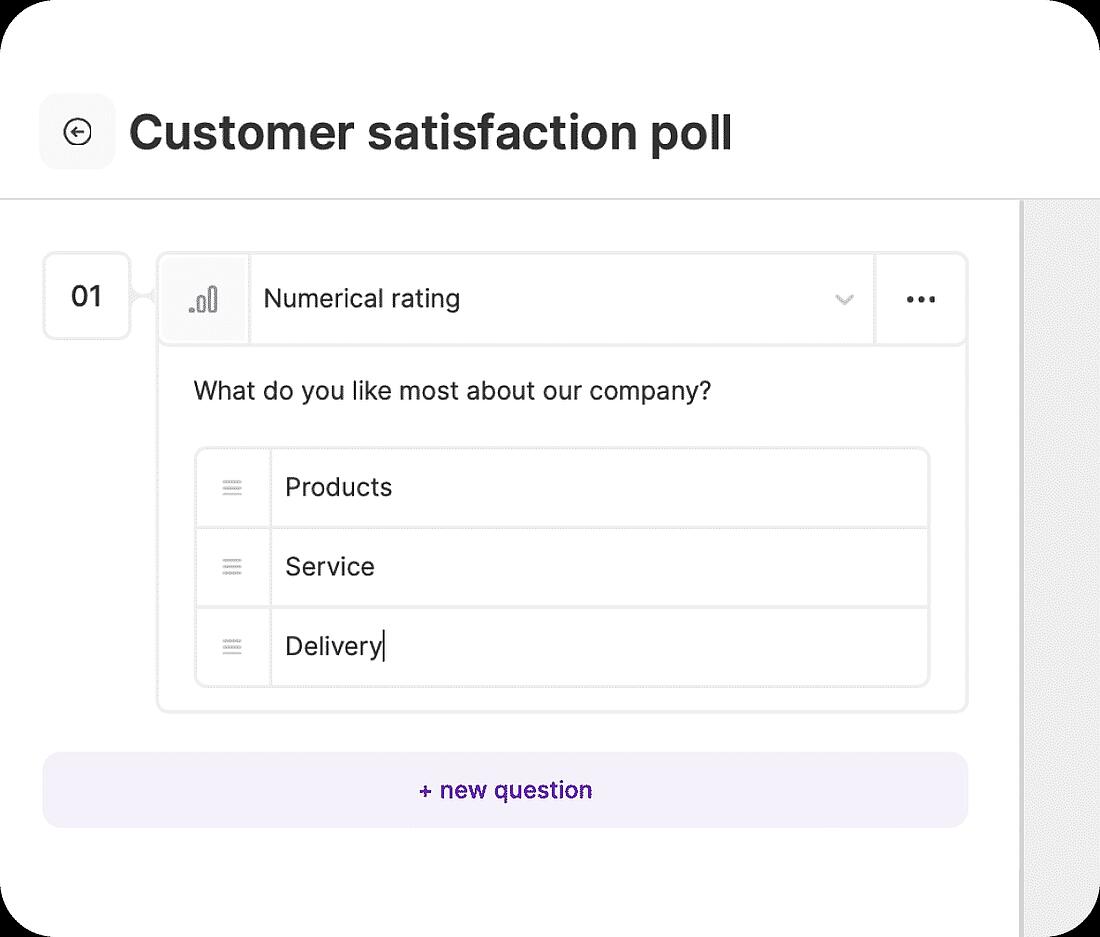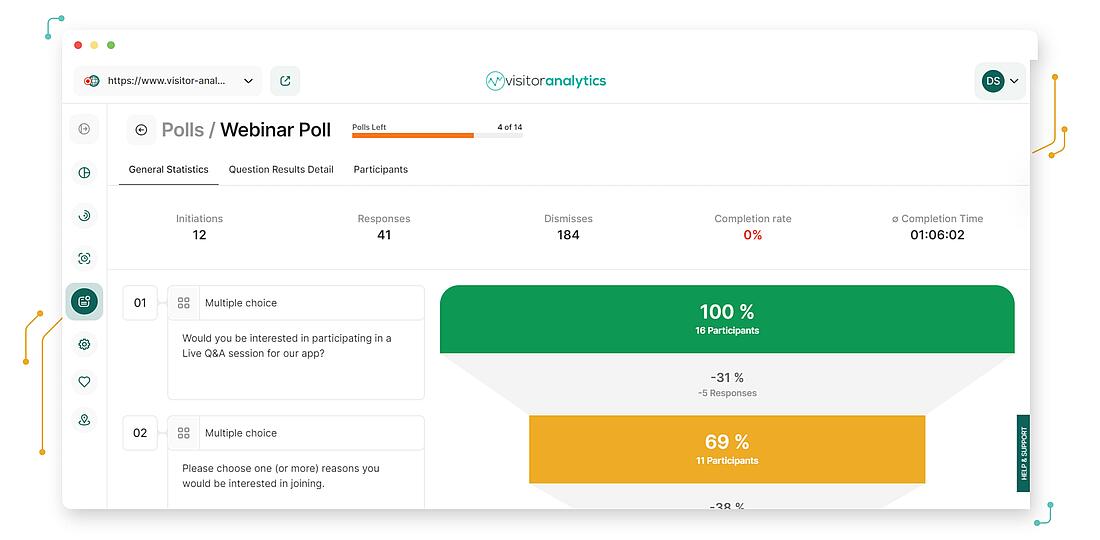- Why Us?
- Features
White Label
For SaaS Platforms & Agencies
Provide our complete analytics suite to your clients, directly within your own interface and with your/their own branding. Discover Analytics-as-a-Service and White Label Analytics. Great benefit, minimal effort.
- Pricing
- White Label
- Success Stories
- ResourcesGetting Started
CONTENTS
- What Are Website Surveys in Digital Marketing?
- Importance of Website Surveys and Polls in Digital Marketing
- Common Issues with Visitor Feedback Tools
- How to Create a Website Survey - a Step by Step Guide
- Other Website Surveys Best Practices
- How to Analyze Website Survey Results
- How to Present Website Survey Results
- How Website Surveys and Polls Work with TWIPLA
- FAQs
Boost Digital Marketing with Surveys & Polls
Website surveys and polls are a simple way to collect targeted feedback from internet users, and to learn what people are thinking when using your website.
They’ve developed considerably since the Statistical Society of London pioneered the first questionnaire back in 1838, and modern website survey tools are now lightyears more developed than the clipboard equivalents carried by city center and door-to-door surveyors.
Today, they offer marketers a fertile avenue through which to learn more about their audience, transforming website traffic into actionable consumer insights that can help with everything from website useability testing and product improvements to the analysis of visitor intentions and behavior.
And thanks to their inclusion in advanced website intelligence solutions like TWIPLA, they enable you to complement the insights pulled from other website analytics tools - empowering you with the means to fine-tune your digital optimization activities.
They are cheap and easy to use, but getting the most out of them requires that you learn a little about web survey construction and analysis - something that this resource hub is here to guide you through.
It will explain what website feedback surveys and online polls are, as well as their strengths and common pitfalls, before explaining how to use them properly.
It also finishes with a list of frequently asked questions if you haven’t quite found the information you’re looking for.

What Are Website Surveys in Digital Marketing?

Website surveys - and polls, their micro questionnaire equivalent - are a visitor communication analytics tool that enables you to collect direct feedback from users about your website or products.
They’re often called website intercept surveys, because of the way that they intercept internet users with questions relevant to whatever they're doing during their browsing session. Put another way, they can be set up to be triggered by a wide range of different website visitor actions:
- On-page arrival - survey appears the moment they open a webpage
- Time spent on site - survey appears after they’ve spent a specific period of time on a webpage
- Exit intent - survey appears when they are preparing to leave the webpage
- Custom event triggered - survey appears when they perform an action of your choice
The above options are enough for a savvy marketer to calibrate website feedback surveys in a multitude of different ways, enabling them to collect real-time feedback from website visitor segments of their choice.
And, learning about how to use website intercept surveys to survey visitors on your website is easy.
Type this term into Google and you’ll be provided with a reasonable amount of advice online - far more than what’s available for the custom event tracking analytics feature, though not quite as much as you will find on conversion funnels, session recordings, and heatmaps.
But while “website intercept survey” is the term that best explains how website surveys and polls work, it remains incomplete since some website analytics solutions like TWIPLA provide additional digital survey tools that don’t intercept, and aren’t triggered by specific user actions.
Instead, they have their own webpages that internet users can access with a link that can be embedded anywhere on your website or across your marketing channels.
This serves to underline that the full functionality of website intercept surveys is often carried out separately, by different tools. With TWIPLA for instance, the polls feature does everything that website intercept surveys are famous for, while the surveys feature enables you to activate longer, off-page questionnaires.
The different types of website surveys and polls will be outlined below, but it’s enough for the moment to say that this gives you more flexibility with regard to survey length and design, and brings with it the capacity to collect even more precise feedback from your audience.
But regardless of their exact technical specifications - this resource hub will split these hairs later - website surveys and polls are all useful for a wide range of digital marketing capacities, including user research, customer experience optimization, and visitor behavior analysis.
Of course, obtaining useful or workable customer feedback needs planning.
It requires that you know how to send online surveys to the right people, at the right place, and at the right time.
You also need good web survey software that meets GDPR requirements with regard to the management of the personal data of your users.
But before anything, getting good customer feedback requires that you create strong, well-written survey questions since this will dictate the quality of the data you collect.
Survey Questions
Online surveys and polls are ultimately vehicles for getting questions under the noses of your customers, and these questions are generally categorized into the following types:
- Open-ended - these enable respondents to give a free-form answer
- Closed-ended - these limit respondents’ possible answers to the options provided
- Nominal - these ask for names or labels that don’t have a numerical value
- Likert scale - these enable respondents to answer within a five or seven-point scale
- Rating scale - these ask respondents to choose from a range of options, scaled between two extremes
- Dichotomous - this type of closed-ended question asks respondents to choose between two possible answers (eg. yes/no, agree/disagree, fair/unfair)
- Ranking - these ask respondents to arrange multiply options into their order of preference
- Multiple choice - these enable respondents to select from a list of replies that you define
- Semantic differential scale - these ask respondents to answer within a multi-point rating system
Of course, your exact choice of questions will depend on the exact feedback you’re looking to collect, and there is an art to both choosing which question type to reach for and writing them properly - something that will be discussed later in this resource hub.
Types of Website Surveys
Today, digital marketers have a wide range of website survey software to choose from. And while they can all be calibrated to collect whatever information you need from the people that matter most, no two are the same from a technical perspective.
This can make it confusing when trying to build a general understanding of how website feedback surveys actually work, or to get third-party advice specific to the platform you’re using.
Simply put, the terminology used for them online isn’t standardized. Names are often used interchangeably, and platforms like TWIPLA can offer multiple survey features that each don’t completely fit the definitions floating around.
What’s more, Google search results for articles about the different website survey types also include a large number of other survey types that are less useful for digital marketing.
From printed questionnaires and telephonic surveys to one-to-one interviews and focus groups, the sheer range of different web survey types being discussed makes it difficult to pull out the specifics you need for your chosen survey type, and you can be unknowingly working with persuasive but irrelevant guidance as a result.
However, website surveys and polls are fairly easy to distinguish, and the below list should help you to identify which of the five types of online surveys that is in front of you:
- Pop-up website surveys - these are also known as on-site or on-page surveys; they appear directly on webpages and are used to gather information about the specific content being viewed by website visitors
- Widget website surveys - these surveys are similar to pop-up surveys but once opened, they appear as an overlay or window over the page that you’re seeking feedback for
- Collapsible pop-up surveys - these are a cross between pop-up website surveys and widget website surveys; they appear on the website visitor’s screen when triggered by a specific event but once minimized, they appear as a small widget in the corner of the webpage
- Off-page website surveys - these are website surveys that appear on their own webpage, and which website visitors can access by clicking a link; these are the least intrusive website survey available, and provide additional space for both content and page design - a good example being TWIPLA’ survey feature
- Online polls - these are otherwise known as microsurveys, being micro versions of pop-up website surveys - TWIPLA brings another great example in its own online polls feature
Ultimately, the web survey types available to you will depend on the platform you’re using.
We’ve written elsewhere about the best website survey tools to use in 2023, and TWIPLA is an excellent example of what more advanced analytics platforms can now provide.
But regardless of the tool you choose, you’ll need to adapt it to the exact requirements of whatever website survey campaign you want to carry out.
Examples of Website Survey Campaigns
Website survey tools are highly flexible, enabling you to collect whatever feedback you want from your audience.
And while there’s no end to the list of questions that you can ask customers, we’ve outlined the ten most popular subject areas for sales and marketing teams below:
- Website satisfaction - this survey type enables you to evaluable how happy internet users are with your website’s design, useability, content, performance, and so forth
- Usability feedback - this survey type exists for you to understand the general useability of your website, and enables you to find out what visitors like and dislike about it.
- Customer demographics - this survey type enables you to collect the information you need to segment your website audience, and to better understand your target market, hidden marketing trends, and make data-driven decisions about future marketing activities
- Exit survey - this survey type exists to learn why visitors are leaving your website, and they activate, for instance, when internet users move their cursor towards the browser’s toolbar
- Customer satisfaction - this survey type gathers feedback about customers’ overall satisfaction with your company’s products, services, website, and/or brand
- Promotion announcements - this survey type enables you to understand where your target audience is most likely to receive information about similar products and services in your industry
- Net Promoter Score (NPS) - this survey type measures the loyalty of customers to a company, and is calculated by asking customers one simple question - “On a scale from 0 to 10, how likely are you to recommend this product/company to a friend or colleague?
- Newsletter signups - this survey type enables you to learn crucial information about website visitors who decide to sign up to your mailing list
- Blog post feedback - this survey type enables you to collect information on website visitors that interact with blogs, such as their demographic characteristics, what content they would like to see more of, any issues they have with the webpage, and so on
- Cart abandonment surveys - this survey type enables you to understand why customers haven’t completed the final stage of the buying process, and is a good way to identify pain points at this important stage of the journey
As you can see from the above list, website surveys and polls enable you to collect the feedback you need to fine-tune digital optimization across all digital marketing activities, and the importance of this to online businesses will be discussed below.

Importance of Website Surveys and Polls in Digital Marketing
Website surveys and polls together make up the full range of visitor communication tools available to digital marketers.
We’ve already written in depth about the five key benefits of website survey tools elsewhere.
But simply put, direct customer feedback matters if you want to find out what your target audience wants from you. This has also never been truer, with constant technological innovation and ever-changing customer preferences making regular dialogue with customers more important than ever.
Website surveys and polls are the best way to communicate with large numbers of customers and prospects simultaneously, enabling you to collect the information you need to maximize the reach of all your digital marketing activities.
This also makes them great for building a community around your organization, to involve your internet users in decision-making in a way that makes them feel seen.
Today, these tools are very unobtrusive and can be customized to match the layout, design, and branding of your website - enabling you to integrate them seamlessly into your webpages. And, particularly with regard to microsurveys like TWIPLA’ poll feature - users can provide their answers with minimal effort.
Consequently, website feedback surveys and polls have a response rate of around 30% (SmartSurvey) - a real strength given that ever-tightening email laws and spam filters have made email far less reliable as an alternative conduit through which to survey customers.
This high completion rate makes them attractive, and all the more so given that they enable you to collect real-time feedback from customers, and to target the right people with the right questions at the right time.
Practically, you can set up online surveys to target whichever audience segment you’re interested in, and you can use the results to quickly learn more about them. And by incorporating this feedback into how you work, you'll see this understanding reflected in higher conversion rates and a lower marketing ROI.
Crucially, website surveys and polls are very quick to set up, taking only a few minutes (once you’ve got the questions ready), and they enable you to collect direct customer feedback in a structured way.
That surveys and polls have stood the test of time and remain popular across industries is itself a testament to their value, but they become even more powerful when used to zone in on issues identified by other website analytics tools, to confirm insights, and to increase the effectiveness of digital optimization activities.
This is because they remove much of the guesswork about the exact intent of website visitors, enabling you to verify your judgment by collecting feedback from the people that are most relevant to your enquiries.
You can also start analyzing responses immediately after activation. This makes them a great tool with which to test any new elements or wider website changes, and to build this feedback into website or product improvements as you go.
Online surveys are also cheap. Monthly subscriptions can cost less than a beer in Qatar, meaning that you can use them to conduct market research - an essential part of effective marketing - at a fraction of what it cost in the past.
Website surveys are also highly versatile. From product research and brand awareness to competitor research and content marketing, they’re a great way to uncover visitor insights that can lead to improved web performance.
The results are easy to analyze - as long as the web surveys have been built properly (more on that later) - and they give you an accurate understanding of the shopping experience from the perspective of your customers.
Taken together, website surveys and polls are a great way to bring in an ongoing pipeline of insights about your customers and website visitors. They’re particularly useful for businesses that are built around the provision of online experiences, SaaS companies, and those that enjoy a high volume of website traffic.
And ultimately, they exist so that you can improve the overall experience of customers, and to give your marketing work focus and clarity.

Common Issues with Visitor Feedback Tools
The potential benefits of website surveys and polls are beyond dispute but maximizing their effectiveness depends on overcoming some common challenges, which will be covered in this section.
Poor Question Choice
Question choice is obviously vital for collecting the data you need to make effective improvements. This issue is particularly present for marketers without any prior web survey experience, and comes from the unpredictable way that users can respond to questions.
For, when confused by poorly wired questions, they simply won’t answer the question in a way that is useful for you, and this can skew the results considerably.
Ambiguous rating systems can also cause respondents to answer differently.
Other problems can arise if the questions do not focus in enough on the specific issues or problems that you want to identify, particularly since website surveys and polls usually don’t provide the space that respondents might need to clarify their answers where appropriate.
Frustrating Survey Length
Survey length can also be an issue. The longer a web survey is, the more respondents will suffer from survey overload - particularly if the online surveys include many open-ended questions that demand long, deep, and carefully-worded answers.
Ultimately, if the survey takes more than fifteen minutes to complete, respondents simply won’t answer them as well, and will be less likely to answer them in the future - explaining the importance of being selective about what online surveys you send out.
Technical Issues
Website feedback surveys are intrinsically tied to the technology you’re using, and website problems, bugs, or glitches can have a domino effect on any live surveys.
The same goes for the feedback survey tool that you’re using, but which can cause further problems if you want to do something outside the payment plan you’re subscribed to.
Survey results can also be affected by issues on the respondents end of the line. Maybe they have technical issues with their computer, connectivity issues, or the survey doesn’t display properly on their mobile device. These can result, for instance, in respondents having to repeatedly restart the survey, give poorly thought out answers, or abandon it altogether.
Mistakes at Launch
Of course, technical issues can ruin the best of launches. At TWIPLA for instance, our marketing team and development team have mutually benefited from the former’s use of online surveys and polls in marketing campaigns of our own.
When you first create a website survey of your own, you’ll no doubt be faced by a similarly omnishambolic hoard of issues you might never have considered beforehand - learning how to draft website surveys that will return useful data, getting your feedback survey tool to activate it properly, and ensuring that data is collected, analyzed and stored in a way that meets the requirements of GDPR and other strict global data privacy laws.
Insufficient Respondents
It’s no secret that the reliability, accuracy, and usefulness of the customer feedback you collect depends on enough internet users filling in the web survey - as well as their relevance to the questions you’re asking.
It’s also important to remember that - even though the response rate is high compared with other digital marketing tools - only a third of your internet users will complete the survey.
As such, smaller online businesses with low website visitor numbers will struggle to collect feedback from enough customers to make the results worthwhile, with on-page surveys and polls better suited to websites that receive thousands of visitors every day.
However, smaller businesses can get around this issue by using the off-page surveys that are provided by advanced digital survey tools like TWIPLA. These can be accessed by links that you can place wherever appropriate on your website and in outreach content, and give you the opportunity to boost the number of respondents considerably.
Poor Analysis
Website surveys are considered the best way to fine-tune the insights you gain from other website analytics tools. However, the answers still lack user intent. You can’t see their facial expressions or body language, and don’t know their thought process when responding to each of their questions.
This issue becomes more complicated when you factor in “survey bias”. This can arise as a result of poorly written questions, but some but even well-worded questions can be interpreted poorly, or respondents might not be comfortable answering certain subject areas.
The results can be affected by the respondents fear of being judged, personality differences, financial problems, and so on. Another thing to consider is that participating in online surveys requires effort, and normally attracts people that have had either a great or a terrible experience - a polarity that will be reflected in the feedback you collect.

How to Create a Website Survey - a Step by Step Guide

Website surveys and polls remain one of the more intuitive tools at your disposal, particularly since platforms make it easy for you to create surveys, deliver them to whichever audience segment you want feedback from, and analyze results.
However, getting the most out of them - and avoiding the various pitfalls outlined above - requires planning. and this section of the hub will now run through the steps required to get the best customer feedback possible.
Establish Your Objectives
It’s best to approach your web survey tool to help achieve any wider departmental or business objectives you have at any given time.
Practically, this means aligning customer surveying with the tasks that you’re assigned with - be it driving conversions, increasing website session times, reducing churn rates, and others.
Website surveys and polls are also particularly potent when used in conjunction with other analytics tools since they enable you to remove the guesswork from assumptions made from other data sources like heatmaps, conversion funnels, and so forth.
As such, it’s best to use them once you know exactly what feedback you need, and to keep this in mind when creating your questions, calibrating triggers, and analyzing results.
Choose Your Audience
Once you know your wider objectives and how a customer survey will feed into them, you’re in a good position to think about which customers, prospects, and other website visitors to target.
This is important, with accurate targeting essential if the web survey is to return insights relevant to the task at hand.
Ultimately, your choice of audience will affect question choice, as well as the best time, location, and survey type - be it on-page, off-page, or widget - for collecting feedback from them.
It’s also particularly useful to target internet users at specific points on your conversion funnels.
Of course, your choice of audience segment may be limited at first to characteristics identifiable as standard by your website survey software such as their device/browser specifications, whether they’re new or returning visitors, geographic location, and so on.
However, you will gradually learn more about your audience, through other web analytics features, online reviews, and market research. You can also directly ask for demographic information in the online surveys themselves, and should do this whenever relevant to whatever feedback you’re seeking.
This means that you’ll get much better at segmenting and targeting your audience over time, which will then naturally enhance the quality of insights that you can pull from website surveys and polls.
Prepare Your Questions
Once you know your web survey goals and target audience, you’re in a good position to focus on the crux of the matter - writing the questions themselves.
Ultimately, the quality of actionable insights that you collect will be largely determined by the choice and wording of the questions that your surveys contain
Practically, questions should complement each other by together collecting the qualitative and quantitative data that you need to get a rounded understanding of the specific issue that you want to investigate.
Put another way, you might want to ask them to rate their satisfaction with your organization. But by itself, this information isn’t particularly useful - you won’t know who they are, what their experiences were, or what you can do to increase their satisfaction in the future.
We’ve written elsewhere about how to write effective survey questions, but you’ll find below a list of tips for writing better website survey questions:
- Write unbiased survey questions that don’t manipulate how respondents will answer
- Don’t write loaded questions that force respondents to give replies unreflective of their opinion
- Don’t build any assumptions into your questions
- Avoid double negatives that can confuse or irritate respondents
- Avoid jargon or any words that people might not understand
- Avoid double-barreled questions that prevent respondents from providing a complete answer
Beyond the above points, it’s also important to remember to keep questions as clear and precise as possible.
You also don’t want to keep them all day.
As such, it’s best to keep your online surveys as short as possible. Short surveys are easier to complete and have higher completion rates. They also stop respondents from suffering survey burnout, and make them more likely to complete another web survey in the future.
Ideally, they should take less than three minutes to complete, and include one main question and a few follow up questions that will help you to add color to the single issue you’re investigating. Play with the wording until you’re confident that the questions are written clearly, while also complementing each other in a way that enables you to dig deepest into the issue at hand.
And when writing your questions, it’s important to remember that timing and relevance are vital characteristics of any successful website survey. Put another way, this means that the questions need to be as relevant as possible to whatever the respondents are doing when they trigger it.
Practically, this means that you set effective targeting parameters for pop-up surveys, or inserting the link to an off-page survey within an appropriate piece of web content.
This will ensure that you don’t - for instance - send a website visitor a survey asking for feedback on their buying experience when they haven't reached that point of the journey.
Prepare Your Answers
When building your web survey, the question type that you choose will set the parameters fields for the answers that respondents will be able to give, and you’ll need to create replies that can be inputted properly into one of these options.
Practically, this means that you’ll need to choose the question type that enables respondents to answer precisely - select the right type and you’ll also find it much easier to analyze the replies you do receive
Unfortunately, every digital survey tool will offer slightly different question type options, meaning that you’ll have to adapt your choice to the technical limitations of your tool - with TWIPLA, you can choose from ten different question types, and you can find out more further down this resource hub.
One great thing about these options is that they enable you to limit your usage of open-ended answers. These have their benefits, but they can be off-putting, drag the survey out, and it can be difficult to analyze what will inevitably be unstandardized replies.
And when writing your answers, it’s important to remember to use clear labeling, wording the answers clearly, and using the custom options to enhance this clarity further.
Build Your Web Survey
Once you’ve drafted your questions and answers around your business objectives and target audience segment, you’re in a good position to build your questionnaire within the web survey tool itself.
Modern iterations are intuitive, making this is one of the easiest steps in the process.
You can find details about how this works with TWIPLA further down this resource hub - or on our visitor feedback support page.
It’s enough to say here that you’ll need to choose the right question type for each question, calibrate the trigger so that it reaches the right people at the right place, and at the right time, and complete a few design fields so that it integrates well with your website layout, design and branding.
Launch Your Web Survey
Once you’ve built the survey in your chosen platform, launching it is simply a case of activating it.
Of course, you’ll want to test it to make sure that the survey is working properly, and you can usually do this yourself - fill the survey in, and then return to the survey software to check that your answers have been recorded.
After this, it’s simply a case of waiting until you’ve collected enough data before analyzing the survey results - something that we will cover in depth later.

Other Website Surveys Best Practices
Ultimately, website surveys and polls can be designed in a way that mitigates the outlined problems. This is also a fairly intuitive process once you’ve got your head around it, and can be done by following a few simple website surveys best practices that will be outlined below:
Don’t Waste Your Customers’ Time
Simply put, there’s no point surveying internet users if you’re not prepared to act on what they say.
Website feedback surveys are a cheap and easy way to gather data about your website, product, and customers, and this brings with it the risk that they’ll be overused - resulting in datasets that won’t ever be used in digital optimization activities.
This is an important point, and all the more so given that customers will be frustrated if their feedback isn’t taken on board, with obvious implications for brand loyalty.
What’s more, too many questionnaires can result in “survey overload”; customers will stop answering them, or they won’t take the online surveys seriously enough - reducing both your completion rate and the amount of useful feedback you collect.
Choose the Right Feedback Survey Tool
We’ve already written about the top 10 best website survey tools in 2023, but it’s still difficult to make generalizations regarding which online survey software or questionnaire tool is right for you.
Website survey widgets, pop-ups, and off-page surveys all have different strengths, making it good practice to choose a platform like TWIPLA that - between our surveys and polls features - arms you with every survey type available, while making the full process of creating, delivering, and analyzing surveys as effective as possible.
It’s also good practice to capitalize on the technical capabilities of these different survey types, and to spread your website surveys out across different touchpoints - anywhere from the homepage through to product description pages and even at key stages during check out.
Use Surveys Alongside Other Analytics Tools
Surveys and polls can be targeted at any issue you want to study, from user research and lead generation through sales, onboarding, and post-purchase.
As such they provide you with both a holistic view of the customer experience, and granular feedback from customers when used properly.
These insights can also be enhanced considerably by using online surveys and polls alongside other website analytics tools - and particularly so if these tools are integrated into the same platform, making it wise to choose a complete website intelligence platform with statistics analytics and website behavior features alongside visitor communication tools.
Session recordings, conversion funnel, and heatmap analyses all provide further insights to what respondents were doing around the time they completed the survey, enabling you to really get into the head of your customers and understand their behavior.

How to Analyze Website Survey Results
Unfortunately, website survey data doesn’t sort and analyze itself, although following earlier advice on how to create a website survey - particularly with regard to selecting the right question types within your survey software - will simplify this task considerably.
Admittedly, a good web survey platform will give you useful information on the number of initiates, completion rate, and average time to complete, and will also tally up the responses for most question types (excluding open and close-ended answers).
But beyond this, you’ll still need to analyze survey results and pull out key trends, behaviors, and other insights that could be of interest to your business, and this section of the resource hub will look at how you can do this effectively:
Understand the Four Measurement Levels
Before approaching the collected survey data, you need to understand the different levels of measurement since these categories will determine the type of statistical analysis that you will perform.
The four measurement levels are nominal, ordinal, interval, and ratio. Let’s look at what these are in more detail:
1. Nominal Scales
The nominal scale is used to categorize non-numerical labels, and is the first level of management that doesn’t establish the degree of variation. Examples of this measurement level include gender, marital status, location, hair color, religion, and race.
And since it lacks numerical significance, all you can do with this data is keep track of how many survey respondents chose each option, and what the response spread was.
2. Ordinal Scales
The ordinal scale is used to show the order of values. It’s the second level of measurement that reports on the ranking and order of data without establishing the degree of variation. Examples of this measurement level include “how happy are you with your product” or “what is your economic status”.
You can analyze both mode and median from this measurement level, and can also take advantage of cross-tabulation analysis.
3. Interval Scales
The interval scale is a numerical level of measurement that places variables into order. Unlike the ordinal scale however, these survey answers have a known and equal distance between them along the scale (think points on a thermometer, keys on a piano, or a star rating).
With interval scales, you can analyze mode, median, and mean, and can also analyze the data through ANOVA, t-tests, and correlation analyses.
4. Ratio Scales
The ratio scale is the most informative of the four measurement scales because it tends to lay out the order and number of the object between the values on the scale Examples of this measurement level include height, money, age, weight, and so forth.
Analyze Quantitative Data First
Simply put, quantitative data is information that can be quantified - it expresses a certain quantity, amount or range. Quantitative data can be given a numerical value and can be counted or measured. Examples of this data type include length in feet, age in years, and weight in kilograms.
Ultimately, quantitative data is valuable because it can be used to draw conclusions, and - unlike qualitative data - it is not subjective. However, since quantitative data comes from close-ended questions, it needs to be converted into numeric data - or quantified - before it can be analyzed.
Regardless, it’s still best to begin with quantitative data when analyzing web survey results, since this will enable you to better understand the qualitative data that you’ll analyze afterwards.
Use Cross-Tabulation
Analyze all responses in a dataset and it’s unlikely you’ll be able to pull out accurate information, particularly since respondents who you wouldn’t consider your target audience can dominate the data and skew survey results.
Cross tabulations mitigate this issue. These are simple data tables that show the results for all respondents alongside the results for sub groups, and enable you to examine relationships within data that would otherwise be very difficult to spot.
Cross-tabulation is best done by dividing your data by demographic since, by comparing data in this way, you can best identify crucial insights about your target audience.
And by pulling out multiple variables from the same data chart, you can narrow down the survey results to a specific group of people, and zoom in on your target audience’s behavior, preferences, and pain points.
Understand the Statistical Significance of Data
As mentioned in the previous section, not all the data you collect will be reliable and it’s vital that you check that your survey respondents are an accurate representation of your target audience.
Of course, the more people you survey, the more accurate the results will be.
However, it’s still important to use your analytics survey software to check the p-value of your data so that you can tell if a data point is statistically significant.
Ultimately, the lower the p-value, the more statistically significant the data point. If the p-value is 0.05, it means that the data point is of moderate statistical significance since there is a 5% chance of error.
And if the p-value is 0.01, it means that the data point is of high statistical significance since there is only a 1% chance of error.
Understand Causation and Correlation
Accurate survey analysis also requires that you know whether or not the conclusions you’re drawing from the data are accurate, and this means understanding the difference between causation and correlation.
Causation refers to the capacity of one variable to influence another.
Correlation, on the other hand, refers to the extent to which two variables are related, and is used to describe relationships between variables that don’t make any statement about cause and effect.
For instance, ice cream sales and shark attacks correlate positively at the beach. Look at the graph for each side by side and you’ll see that shark attacks increase when ice cream sales go up.
However, this relationship is correlational rather than causational.
What this shows is that data analysis will suggest a relationship between two variables (or data points) when the correlation is actually caused by a third factor that you may not yet have identified.
Sharks, for instance, don’t suddenly become rabid the moment a scoop of raspberry ripple falls into the ocean - shark attacks and ice cream sales aren't directly related, but spike together when temperatures go up and people flock to the beach.
As such, it’s important not to make conclusions that are inaccurate or insufficient, and to analyze all the data you have before making potentially dangerous assumptions about what has influenced their survey responses, website behavior, and so on.
Compare Feedback with Historical Data
Getting the most out of customer feedback requires that you compare survey results with historical data whenever possible since this will enable you to gauge business performance over time.
This is particularly useful for tracking the effectiveness of digital optimization activities, as well as for identifying new issues to explore.
You can even track data for specific subgroups to see if their experiences improve with your initiatives.

How to Present Website Survey Results
Once you’ve collected, sorted and analyzed the results of a survey, you may well need to present your findings.
Of course, the specific campaign or goals behind the web survey will shape what information you include and how it is displayed, as will the audience - colleagues, management, customers, and other stakeholders will all require different things.
Thankfully, it's easy to visualize filtered datasets.
Many digital survey tools like TWIPLA have dashboard and other reporting features, and you also have the option to migrate data to spreadsheet software that can automatically illustrate it in a multitude of different ways.
But regardless of method, survey results need to be presented in a way that makes your conclusions easy to understand, which is why it’s important to choose your display method carefully and this next section will run through the different options available to you.
Spreadsheets and Data Tables
Spreadsheets and data tables are the most basic way of displaying survey results.
And while they’re not as attractive as the other presentation options that are covered here, they still remain a useful way to show large amounts of data, and are great when the information speaks for itself.
Crucially, modern spreadsheet software like Microsoft Excel and Google Sheets enables you to easily filter data down to what you want to present, and can translate the survey results into a range of different charts, tables, and graphics - enabling you to visualize it in a way that makes the data easier to understand.
Live Presentation
Conducting a live presentation is still probably the best way to decipher your survey results, with live interaction and discussion vital for ensuring that your audience fully understands the findings in real time.
Of course, creating and leading a presentation is an artform in itself, but it can really help to improve engagement, collaboration, and decision making.
What’s more, presentation software enables you to integrate any type of media imaginable, enabling you to sell the story behind your statistics in an entertaining way.
Graphs, Custom Charts and Diagrams
Graphs and charts summarize survey results in a quick, easy graphic for people to understand. Some of the most common types of graphs include:
- Bar graphs
- Line graphs
- Pie charts
- Venn diagrams
- Word clouds
In most cases, it will be fairly obvious which of the above graphic types enables you to best visualize your dataset.
However, it’s still important to make the web survey findings easy to read, with color coding particularly useful to this end. But ultimately, it’s best to keep the graphic simple, and to avoid intersecting lines, text, and unnecessary labels.
It’s also important not to squeeze too much information into one graph, and to instead consider spreading the findings across multiple graphs and charts wherever possible.
Infographics
An infographic is a visual representation of information.
It is made up of images, data visualizations, and text that can together bring survey results to life.
Infographics add a creative twist to what could otherwise be boring tables, charts, and text, and there are many examples of infographics that have gone viral.
When done well, they’re a powerful way to enhance findings and bring data to life, with engaging visuals that make complicated findings easy to understand.
Video and Animations
Videos are a useful tool for presenting information, including survey results, because of the way your findings can be jazzed up with animation, sound, and other effects.
Ultimately, they’re a great way to hold your audience’s attention, with audio, sound, and motion all helping them to get to grips with the subject.
Videos can be sliced up to suit whoever you’re presenting to, or uploaded onto your website, marketing materials or video hosting platform. However, sharing options are still restricted to channels that are able to play a video, giving you less options than you have with text or images.

How Website Surveys and Polls Work with TWIPLA
TWIPLA offers two visitor communication features that together give you real flexibility with regard to collecting feedback from internet users.
This section will provide a broad introduction for how they work; they’re intuitively designed, but you can find more detailed information on our visitor feedback support page.
These tools offer different survey types, with the main difference being the types of questions they’re suited to. Specifically, the survey feature enables you to create questionnaires that appear on their own webpages, while polls enable you to integrate quick feedback bubbles into pre-existing webpages.
Ultimately, the survey tool exists for creating longer questionnaires, while the polls tool is a better option for shorter questionnaires that don’t require many long free-form answers.
And while your choice of poll will depend on the specificities of individual questionnaires, the set up process is very similar. It’s also easy to do, particularly since a mouse hover will reveal helpful information for each of the input fields in front of you.
Website Surveys and Polls Dashboards
Go into your surveys or polls feature in TWIPLA for the first time and you’ll be welcomed with a prompt to create your first questionnaire.
Once you’ve done this, these dashboards will be populated with key information on any of your live, dormant, or drafted questionnaires:
- Title - this is the name you gave each survey/poll
- Status - this shows whether the survey/poll is live, inactive, or saved as a draft
- Created at - this is the date that the survey/poll was created
- Initiates - this shows the number of internet users who have replied to at least one question
- Responses - the number of internet users who completed the survey/poll.
- Completion rate - the proportion of participants that completed the survey/poll
- Completion time - the average time those surveyed took to finish the survey/poll
There’s also an additional settings column with clickable icons that enable you to pause, activate, edit or delete any of the questionnaires. And with polls feature, there’s also an icon that will show you an analytics report of results.
Inputtable Question Types

With TWIPLA, both the web surveys and polls features enable you to choose from ten different question types, which can be selected from a dropdown menu:
- Short text questions - these limit respondents to 280-character replies
- Long text questions - these limit respondents to 4,000-character replies
- Multiple choice - these give respondents up to six answers to choose from
- Slider - these ask respondents to rate their opinion on a sliding scale of one to one hundred.
- Numerical rating - these ask respondents to choose a value from the custom list of three options
- Shape rating - these are similar to the numerical rating, but replace values with emojis (stars, hearts, and thumbs)
- Email address - these ask for respondents’ email addresses, which can be validated through the survey tool
- Phone number - these ask for the respondents’ phone numbers, including the country code
- Website link - these ask for the respondents’ website address, and the survey checks whether the respondent has entered a link in the reply
- Date - these ask respondents for a specific date
Each question type has a different answer field, meaning that your choice will ultimately dictate how easy it is to analyze the results.
And when building your survey and poll, you’ll find different, additional options for each question type by clicking on the adjacent horizontal, three-dotted “meatball” button.
And once inputted, the questions will be saved in a question bank so that you can reuse them in later surveys and polls.
Appearance Options
Once you’ve inputted your questions, you then have the option to customize the look of your survey or poll.
Both tools enable you to calibrate the appearance of a questionnaire by:
- Setting the language
- Adjusting the main color
- Adjusting the background color
- Adding a logo
However, the surveys and polls tools will present you with further appearance options for each.
As an off-page questionnaire builder, the surveys feature enables you to determine whether respondents are presented with the survey one question at a time, or all at once, and you can also activate a survey progress bar and completion redirect link.
On the other hand, the polls feature generates micro pop-up website feedback bubbles, and it has appearance options that are related to rule-based targeting.
Put another way, it enables you to specify which webpages it will appear on, whether it appears in the left-bottom or right-bottom corner of these webpages, and both the horizontal and vertical padding.
Publishing Surveys and Polls
Activating your new web survey or poll is straightforward once all the questions have been created, answers defined, and you’ve inputted any targeting or customization that you want.

After this, it’s simply the case of clicking on the activation button - either within the editing mode, or directly in list mode. However, you can also choose not to publish it immediately by leaving it as a draft.
Of course, it’s important to check that an activated survey or poll is working properly, something that can be done by simply completing the questionnaire and checking that the feedback has been recorded by the TWIPLA feature.
Analyzing Results
Surveys and polls will be collecting data once they’ve been activated, and you’ll receive your first data once the first internet user has completed the first question of it.
To view this data, you need to go to list view and click on the statistics item for the survey or poll that you want to analyze.
For surveys, you’ll be shown general statistics on the number of initiations and responses, as well as the completion rate and completion time. You’ll also find the survey results themselves, with a percentage breakdown of respondent answers and total number of respondents for each question.
And will polls, you’ll find a tab with further details about your respondents that you can use to filter web survey results by audience segment.
These include whether they’re new, returning, or conversion visitors, their location, technical specifications (device type, operating system, and browser), completion time, completion rate, and completion date.
FAQs
What Is a Website Survey?
Website or online surveys are questionnaires that businesses can use to learn about their customers, target audience, and other internet users. They can vary considerably in terms of length and appearance, from long off-page surveys to micro pop up feedback polls, and are a great way to fine-tune optimization work.
Why Are Website Surveys Necessary and Valuable?
Website feedback surveys enable you to engage with your target audience, and to get precise real-time feedback from the right people, at the right place, and at the right time for whatever digital marketing responsibility you are focused on.
Simply put, website surveys and polls enable you to conduct market research at a fraction of what it normally costs, and to learn about your business from the perspective of your customers. They’re also useful for a wide range of marketing tasks, including product and competitor research, brand awareness, and content marketing.
What Are the Types of Online Surveys?
Modern website surveys have a wide range of different technical specifications.
On-page surveys - otherwise known as pop-up or on-site surveys - appear directly on whatever webpages you’ve chosen, while off-page surveys appear on their own dedicated webpages.
These different types are also offered in widgets with different triggering mechanisms, audience targeting capabilities, and appearance, with your choice dependent on the specificities of whatever task you need visitor feedback for.
What is the Difference Between Website Surveys and Polls?
Website surveys and polls are very similar, and together form what is known online as “website intercept surveys.” The main difference is one of length - website surveys are long questionnaires that often have their own dedicated webpages, while polls are microsurveys, and often appear in the form of a pop-up widget or feedback bubble.
How to Add a Survey to My Website
Surveying your website visitors is simply a case of opening an account with a survey software, web analytics solution like TWIPLA, or other marketing technology that provides surveying or polls tools. Once this is done, online surveys can be set up in minutes, with much of the results analysis done automatically by the platform.
How Do You Create a Website Survey?
After choosing and activating your chosen tool, creating a website survey requires writing your questions, choosing the right answer fields, and calibrating the layout, appearance, and targeting options. And once live, websites with high traffic will start receiving results immediately, which can then be analyzed at your leisure.
Where on Your Website Should You Ask Survey Questions?
The various different website survey technical specifications available means that you have real flexibility with regard to where online surveys appear, when they appear, and who they appear to.
This enables you to optimize your survey to the specificities of the website issue at hand, and to dig deep into the characteristics of the survey respondents.
Are Website Surveys Legal?
Website feedback surveys are legal because customers are under no obligation to complete them and, by doing so, they are providing the legal basis for consent.
However, it’s still important that businesses comply with modern data privacy laws with regard to how they collect, store, and analyze this personal data - something that is done automatically with some website survey tools like TWIPLA.
Start Collecting Visitor Feedback Today!
As you can see, website surveys and polls are a fantastic tool for collecting direct feedback from internet users, and you can use these insights to really fine-tune your customer service, product delivery, and overall reputation online.
There’s no shortage of website survey tools out there to suit any business, but TWIPLA offers these tools within a complete website intelligence platform. And as a privacy-first solution, it removes the need to build compliance procedures for GDPR and other data privacy laws into an important area of responsibility for marketing.
If you found this article useful - particularly given how confusing much of the information online is - and think it would be useful to other digital marketers out there, feel free to share it around.










